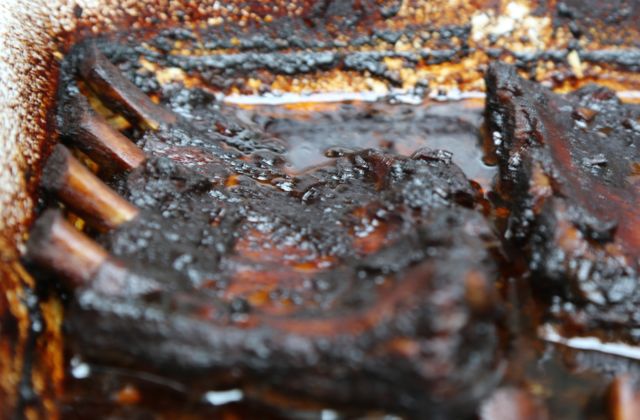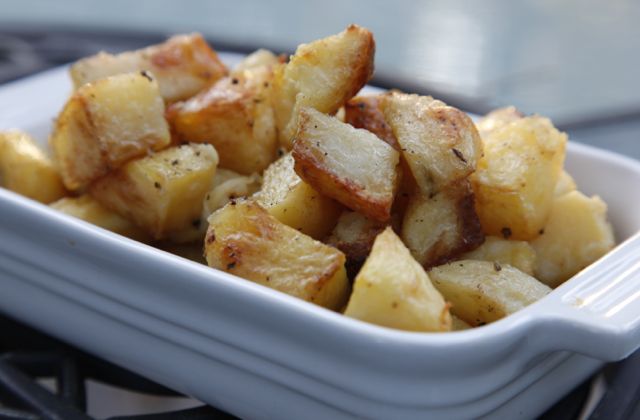We are all connected to the seasons. That’s why we crave light salads and chilled watermelon in the summer and root vegetables and roasts in the winter. As I pull the collar tighter around my neck on this frigid winters day, I can feel my body craving savoury foods.
Isn’t it wonderful that when we begin to crave certain things, Mother Nature is right there to provide them for us? Winter is the time for root vegetables; farmers have long ago picked the last of the potatoes, carrots, squash and onions from the fields. They all go together in one roasting pan with plenty of the season’s last herbs. It’s a savoury vegetable medley that becomes scrumptious when slowly roasted with meats and poultry. When it’s done, the kitchen is full of the spellbinding smells of an autumn kitchen. Lay them on a plate and dig in; it’s magically delicious and magnificently satisfying on a winters cold night. Good home cooking doesn’t get any better.

My favourite way to eat mushrooms is roasted. I don’t like them raw in a salad, they can be so bland; cooked improperly they can be slimy. But properly roasted, they become meaty, deeply flavoured and like a sponge, intensely flavoured by other ingredients in the pan.
A superb pan of roasted mushrooms is easy enough to perfect. Trim, wash (yes, it is ok to wash mushrooms) and quarter big white mushrooms. Plan on using twice as many as you need because mushrooms shrink down to about 50% of their original size – but become a hundred times more flavourful! Toss them with olive oil, salt and pepper and roast them in a moderate (350-375F) oven for about 15 minutes. That’s long enough for them to release all their liquid.
The key to great mushrooms is to completely drain this liquid so they don’t end up steaming or boiling in their own juices. Mushroom juices are flavourful and nutritious so keep them for your next pot of soup. Once drained, drizzle with a bit of olive oil, sprinkle with your favourite herbs and continue roasting until browned, about another 30 minutes or more depending on your oven. Or if you have a joint of beef or whole chicken baking away, you can put them around the roast at this point and carefully spoon pan juices over them for more flavour. Tear pieces of bread from a French loaf and dig in, you’ll love these savoury, meaty mushrooms.

When the snow is blowing outside, there’s nothing better than a rack of ribs roasting for hours in the oven. The slow and low method tenderizes ribs like parboiling can’t. Rub them first with a dry rib rub so the flavour sinks in slowly. After 4 to 6 hours, turn up the heat, slather them with a zesty barbecue sauce and let them caramelize well. Now pile them on the dinner table. The outsides will be crunchy and glazed, the insides so fork tender the meat will simply fall off the bones. Make enough for seconds!

While the oven is hot, take advantage of it and roast some potatoes to go along with those ribs. What? Your oven-roasted potatoes are a little bland and mushy? If you love potatoes and want the crustiest potatoes with soft centres, it’s not just a matter of throwing them into a roasting pan. You need to build the crust.
My grandmothers’ secret was to pre-boil her peeled and quartered potatoes in water spiked with a tablespoon of vinegar. I’m not sure what that does but no matter what I do differently, my potatoes never come out as good as hers. Once boiled, drizzle olive oil on them or use my secret ingredient – duck fat! Toss really well to coat them completely and roast them in a very hot oven (450-500F) until absolutely insanely crisp.

Chef Amy Proulx, Professor of Culinary Innovation and Food Technology at Niagara College explains, “it’s like making jam. We add lemon juice and pectin to fruit. The lemon juice acidifies the pectin so it will gel.” When vinegar is added to potato water, it acidifies the pectin in the potato and it forms a gelatinized layer on the potato. When cooked at high temperatures, like roasting at 450F, the gelatinized layer crisps up. If you coat them with fat such as olive oil or duck fat, they crisp into the delicious crust we crave with soft billowy insides. So the thicker that layer, the better the crust. “This way you don’t get that pasty texture to your roasted potatoes.”
Good home cooks like my grandmother don’t necessarily need to know the science behind successful cooking techniques; they just trust that they work. You’ll love these roasted potatoes and will want to make them with all sorts of roasted meats, especially a brined chicken. You can find brining salts in a grocery store. Boil them in a quart of water, add plenty of cold water and totally immerse a chicken in the liquid. Let this sit overnight while the saltiness gets into the flesh of the meat, tenderizing and making it ultimately more juicy than the chicken can be on it’s own.
I add a jug of cold apple cider to the warm brine and top with enough cold water to cover the chicken. With the lid on, it sits in the cold garage overnight (doesn’t fit in my refrigerator). When ready to cook, roast the chicken according to your favourite recipe and you’ll end up with uber juicy and fork tender white meat and addictive deliciousness that will have you brining and roasting every cold weekend.

How many times have you tossed root vegetables with oil, thrown them on a baking sheet and cooked the in a hot oven until tender? And on a scale of one to ten, how exciting are they? Ok, to get more out of your roasted vegetables, it helps to understand each one’s unique characteristics, where you want them to go and how to take them there.
Take carrots for example. Unlike potatoes, they are loaded with sugar that caramelizes and browns for a different complexity of sweet flavours. The challenge with carrots is that by the time they’re soft and caramelized, they’re usually shriveled.
Try pre-boiling scrubbed but not peeled, fresh carrots in salted water until almost al’dente. Fresh carrots are the ones with their tops still attached. Bags of stored carrots (without their tops) are thicker and firmer and will need to be cut. Once pre-boiled, drain and toss with olive oil and add your favourite fresh herbs. Finish them in a moderate oven (350-375F) for about 40 minutes. The pre-boiling will add a bit more moisture so the roasted carrots don’t shrivel. If you’re looking for a way to eat more root vegetables, this is also a great way to cook parsnips.

Growing up as a child, I always hated Brussels sprouts. But not today! I trim them and cut them in half, toss them in olive oil and diced, cooked bacon. Season well, then roast in a hot oven with the bacon, in a single layer on a cookie sheet, cut side down. When they’re browned on the bottom, transfer them to a bowl and watch as your family devours them, they’re super-delicious and easy to roast.
Proper roasting techniques is the key to savoury, rich-tasting meats and vegetables with little fat (except for my potatoes!) Farmers’ markets will have all the necessary root vegetables all winter long so you can still base your roasted choices on spontaneous whims. Try to balance earthy tastes like rutabaga, celeriac, parsnip, Brussels sprouts and turnips with sweet, rich vegetables such as onions, potatoes, yams and carrots. So let the winter bring on the cold weather, I’m roasting inside!
For more winter roasting ideas see my Pinterest page.
